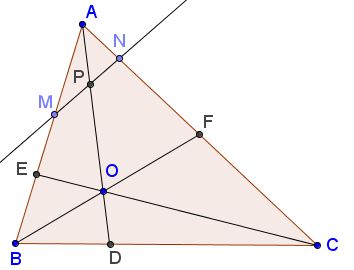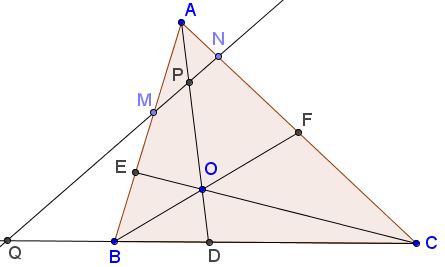Van Khea's Fourth Identity in Triangle
Let $O$ be a point inside $\Delta ABC.$ Lines $AO,BO,CO$ cross the sides of the triangle at $D,E,F,$ as shown:

Line $MN,$ with $M\in AB$ and $M\in AC$ intersects $AD$ in $P.$ Prove that
(*)
$\displaystyle \frac{BM}{MA}\cdot\frac{AE}{EB}+\frac{CN}{NA}\cdot\frac{AF}{FC}=\frac{AO}{OD}\cdot\frac{DP}{PA}.$
(Note that in (*) and also below all segments are thought to be signed.)
Proof
The case $MN\parallel BC$ being trivial, we assume without loss of generality that $MN$ meets BC in $Q$ such that $B\in QC.$

(1)
$\displaystyle\frac{AE}{EB}+\frac{AF}{FC}=\frac{AO}{OD}.$
By Menelaus' theorem in $\Delta ABD$ and the transversal $PMQ,$
(2)
$\displaystyle\frac{BM}{MA}=\frac{DP}{PA}\cdot\frac{QB}{QD}$
and in $\Delta ACD$ and the transversal $PNQ,$
(3)
$\displaystyle\frac{CN}{NA}=\frac{DP}{PA}\cdot\frac{QC}{QD}.$
Substituting (1-3) into (*) results in an equivalent identity:
$\displaystyle\frac{QB}{QD}\cdot\frac{AE}{EB}+\frac{QC}{QD}\cdot\frac{AF}{FC}=\frac{AE}{EB}+\frac{AF}{FC}$
which, in turn, can be transformed into
$\displaystyle\frac{AE}{EB}\cdot\frac{QB-QD}{QD}+\frac{AF}{FC}\cdot\frac{QC-QD}{QD}=0,$
or,
$\displaystyle\frac{AE}{EB}BD+\frac{AF}{FC}CD=0,$
which is equivalent to
$\displaystyle\frac{AE}{EB}\cdot\frac{BD}{DC}\cdot\frac{CF}{FA}=1.$
The latter is the Ceva condition for $\Delta ABC$ and the cevians through $O.$
Acknowledgment
The problem has been sent to me by Leo Giugiuc with credits to Van Khea. The proof is by Leo Giugiuc.
|Contact| |Front page| |Contents| |Geometry|
Copyright © 1996-2018 Alexander Bogomolny
73511825
